Caring for an Antique
Clock - Part I
by Bob Brooke
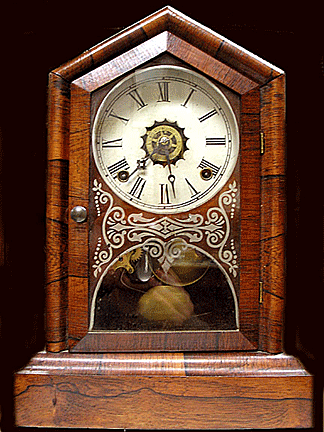 Most
antique clocks are valuable mechanical instruments. As such, they need
to be cared for regularly, but few people do. Perhaps they take them for
granted since modern digital clocks run continuously as long as they
have power. But while a modern clock may keep on ticking, it’s much like
a robot. An antique clock, on the other hand, has a soul—a soul that
needs looking after. Most
antique clocks are valuable mechanical instruments. As such, they need
to be cared for regularly, but few people do. Perhaps they take them for
granted since modern digital clocks run continuously as long as they
have power. But while a modern clock may keep on ticking, it’s much like
a robot. An antique clock, on the other hand, has a soul—a soul that
needs looking after.
General Care
Antique clocks generally suffer from three things—careless positioning,
incorrect display, and over-enthusiastic handling. Believe it or not,
direct sunlight can harm them, and so can extremes of temperature or
moisture.
Have your clock lubricated service every four or five years—it costs
less than you think. And a full service at 10 years. An antique clock
normally runs constantly, so it works much harder than your car which
will demand servicing more frequently, plus it costs a fraction of what
a car does to be serviced. The wear and tear is cumulative.
Positioning an Antique Clock
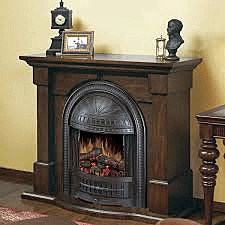 The
worst location for an antique clock is on a mantelpiece over a working
fireplace. Probably because the mantel was often the centerpiece of the
room and was a convenient place to put a clock. The
worst location for an antique clock is on a mantelpiece over a working
fireplace. Probably because the mantel was often the centerpiece of the
room and was a convenient place to put a clock.
Don't position your clock above or close to a radiator, or in direct
sunlight, or where children’s fingers can reach it. Changing
temperatures and humidity are harmful in the long term but even in the
short term lead to poor timekeeping.
Careless or unexpected movement can also affect the workings of a
clock’s delicate mechanism. All long case standing clocks and wall-hung
varieties should be screwed to the wall or to a solid wooden wall
bracket or mount to keep them from getting out of beat.
To maintain accurate time, a clock must remain “in beat.” Once a clock
has been leveled, it will produce a perfect beat or cadence to the
tick-tock. The sound should be consistent with even spacing between each
“tic” and “toc.”
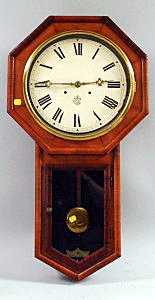 Hang
a wall clock on a decent length screw properly secured in the wall, and
never on string, a nail or a picture hanger. Unless secured at the
bottom as well, also remember that when you open the door to wind it,
the clock case will kick sideways. Hang
a wall clock on a decent length screw properly secured in the wall, and
never on string, a nail or a picture hanger. Unless secured at the
bottom as well, also remember that when you open the door to wind it,
the clock case will kick sideways.
Before moving an antique clock, check that there are no detachable parts
and don’t rely on handles but hold the object under the base with both
hands. And secure the clock key or keys—should your clock have a winding
key or crank and a door key.
Secure the pendulum of a spring clock by the clip provided or by the
spring clamp on many English bracket and mantle clocks. Otherwise remove
the pendulum. And remove the weights and pendulum on any clock that has
them. For tall case or grandfather clocks, also separate the case hood
and movement. If the suspension rod to which the pendulum is attached
set in motion while being moved, let it run down completely.
Cleaning an Antique Clock
Cleaning an antique clock should be done very carefully with a soft
lint-free cloth and a soft-bristle brush. Avoid metal polishes which may
seep into the movement or destroy a valuable patina, like the patina on
a brass carriage clock.
Unless the finish is totally ruined, do not refinish the case, as this
can affect the clock’s value. There are products designed specifically
for cleaning clock cases, so if you feel you must clean the case, use
Murphy’s Oil Soap or Merritt’s Clock Cleaner (Curator’s Clock Case
Restorer).
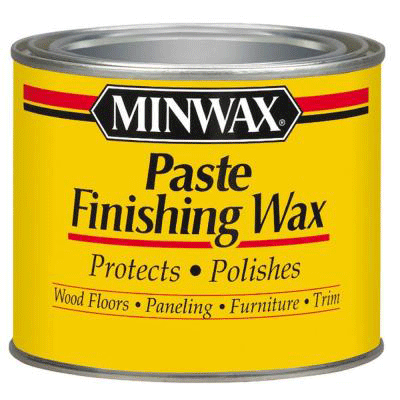 Use
a Minwax Paste Wax to polish the wood case and avoid silicone spray
polishes. Use
a Minwax Paste Wax to polish the wood case and avoid silicone spray
polishes.
They’re designed to create an intense shine but clog the pores and
grain, preventing the natural wood from breathing.
For stubborn marks on a glass face use a cotton ball damped in a mild
detergent solution or methylated spirits. Rinse with another damp cotton
ball and buff gently with a chamois. Don’t attempt to clean any of the
mechanical parts of a clock movement yourself. Leave that to a clock
specialist.
Do not attempt to polish the metal dial with any metal polish. While
most metal dials are ‘silvered’ – the layer is so thin that any attempt
to polish will most likely result in wearing the finish off. This is
also true for bezels. So resist the urge to polish. Getting a dial
re-silvered can be expensive, as the numbers will have to be repainted,
also.
Keep the Clock Running
Keep an antique clock running. It won’t wear out for decades and can
always be repaired when it does. A clock that is left idle for weeks and
months will eventually dry up and tends to be more difficult to get
going again without proper service.
 Make
sure that the key is the correct one for the clock and only turn it
firmly to the point of resistance. If you go away longer than the next
due winding, stop the clock to avoid damage to the escapement when it
winds down. Make
sure that the key is the correct one for the clock and only turn it
firmly to the point of resistance. If you go away longer than the next
due winding, stop the clock to avoid damage to the escapement when it
winds down.
If an antique clock is an 8-day clock, wind it fully every week on the
same day. Most 8- day clocks will run for 10 to 12 or even 14 days but
the timekeeping deteriorates progressively after 7 days as the
mainspring gradually loses power. If it's a 30-hour clock, wind it every
night before bed for the same reason.
Not all clocks wind in the same direction so make sure you’re winding
your clock in the correct direction. Don’t be afraid of overwinding your
clock. The key of a fully wound clock comes to a complete stop and won’t
go beyond that point.
If your clock has a pendulum, you can lengthen the effective length of
the pendulum to slow down the clock; if you shorten the effective length
of the pendulum the clock will run faster. How much you adjust the
pendulum will depend on each individual clock.
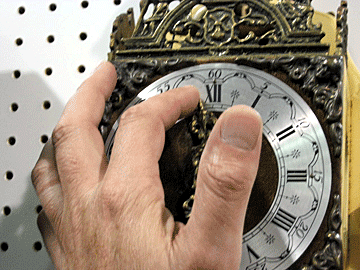 To
adjust the minute hand of a clock, gently turn the hands clockwise—never
counter-clockwise. If the hands jam, move the minute hand back a
fraction but never back past the hour. If this doesn’t free them, take
the clock to a clockmaker. To
adjust the minute hand of a clock, gently turn the hands clockwise—never
counter-clockwise. If the hands jam, move the minute hand back a
fraction but never back past the hour. If this doesn’t free them, take
the clock to a clockmaker.
Likewise, don’t try to oil or lubricate an antique clock in any way.
Even oiling the mechanism of a valuable clock can be risky if you don’t
know where to apply it, and too much or too thick an oil can attract
abrasive grime which can affect the mechanism. Horologists use a special
oil that enables the smooth operation of a clock movement.
Even if an antique clock seems to be in good working order, have it
periodically checked by a professional. Weight-driven clocks go for a
longer time between servicing while clocks with a balance wheel require
shorter periods between servicing because their finer parts wear down
faster.
<
Back to Caring for Your Collections
Archives
Next Article >
|
